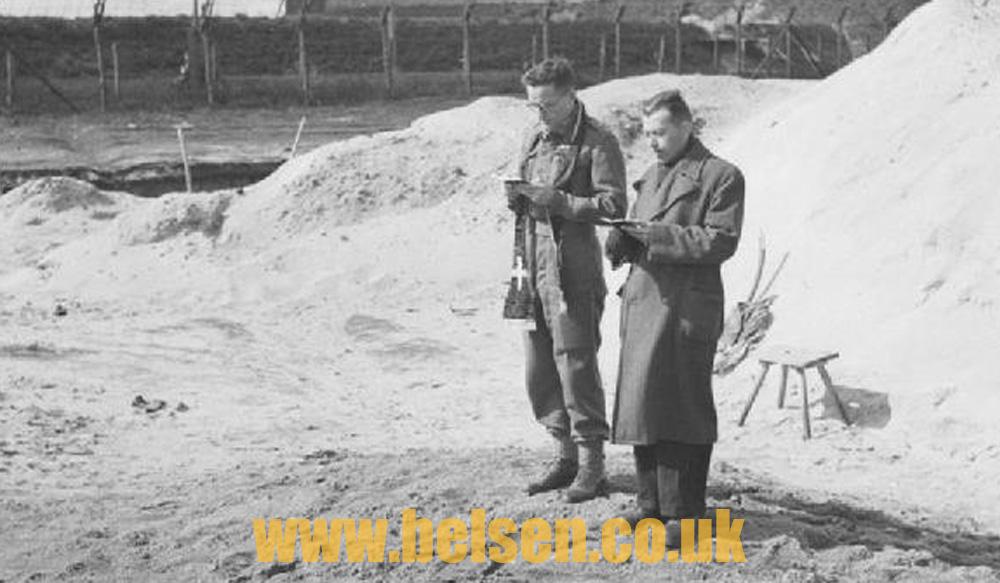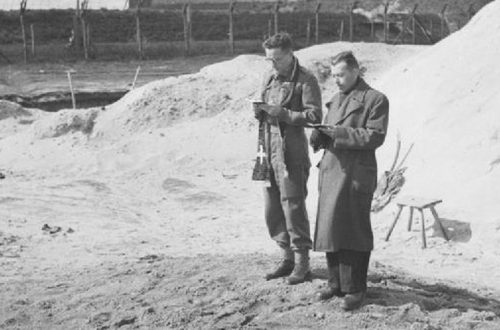Michael Morrison – Priest
ON 15 APRIL 1945, British and Canadian troops entered the Bergen-Belsen concentration camp in western Germany.

Among the liberators was Irishman Michael Morrison, a jesuit priest serving as a chaplain with the British army.
(Update part of 32nd CCS – ED)
This camp was the first to be liberated on the Western Front and, as a result, the soldiers had little idea of what they’d be faced with as they entered.
Bergen-Belsen was designed to hold 10,000 people. On this day in 1945, 60,000 were squashed into the camp.
Unlike Auschwitz and other camps, there were no gas chambers at Belsen.
Nevertheless, the appalling conditions there meant that more than 50,000 people died at the camp between 1941 and 1945.
Among them was Anne Frank, the young Jewish diarist, who died just three weeks before the camp’s liberation.
The utter devastation of the camp was laid bare in the stark pictures of mass graves and people suffering from severe malnutrition.
In those first few days and weeks in the aftermath of the liberation, Father Michael Morrison worked round-the-clock to help the wounded and tend to those still alive in the camp.
What he witnessed changed him utterly, leaving scars that never appeared to heal.
“Utterly beyond description”
The Listowel-native had been ordained a priest in 1939, and joined the British army in 1941.
Originally serving with the 2/5th Battalion of the Welsh Regiment, Morrison was moved to the 2/8th Lancashire Fusiliers, Derry regiment in 1944.
He served as a chaplain until his regiment was sent to Belsen in April 1945.
In diary entries, he detailed what faced the liberators when they first entered the camp:
“What we saw within the first few days is utterly beyond description… people crawling on their hands and knees because they have not got the strength to walk, or see them drag themselves along until they fell in the gutters to remain there, it was harrowing.”
“Many of the bodies showed signs of cannibalism, with their livers removed. It is easy to understand when you consider the ration was half a litre of turnip soup and 120 grams of bread a fortnight.”
To put that in perspective, 120 grams of bread every two weeks would roughly correlate to just over two slices of bread per person.
Morrison spent his first week in the camp anointing about 300 dying people per day. He would stop only for two short meal breaks a day.
Diseases such as typhus were rampant throughout the camp’s prisoners.
The number of those dead was so high that the British army used a bulldozer to put the bodies into a mass grave.
“Enteritis was very prevalent… in one hut two hundred and twenty had it and those statistics were compiled after several had died off. The majority of these people were too weak to leave their beds, so perhaps you get just a faint idea of the atmosphere.
The work has been physically the most revolting that I have been called on to do, but it has also been the most consoling.”
When the number of the sick and the dead that Morrison anointed began to lessen, he decided to hold a mass at the camp.
As the rain lashed down on the day of the mass, he considered calling it off, thinking that no one would bother turning up.
As he walked out onto the makeshift altar, he was taken aback to see hundreds of people from different religions waiting.
At Bergen-Belsen, there were French, Dutch, Poles, Hungarians, Belgians and more.
When the pictures showing the horrors of the camp reached the general public, it had a lasting effect on the perception of the Nazis, and the atrocities they perpetrated, around the world.
Playwright Alan Bennett, who saw the newsreel detailing the liberation as an 11-year-old boy said Bergen-Belsen “was not a name one ever forgot and became a place of horror long before Auschwitz”.
The British torched the camp, burning it to the ground several months later but that didn’t prevent the scars from lingering for quite a long time.
Despite his work in helping at the camp, what Morrison witnessed during his weeks at the camp had a profound and lasting effect.
Conor Dodd, historian at Glasnevin Cemetery, told TheJournal.ie: “It affected him for the rest of his life. He never quite got over it.”
After the war, he briefly served as a parish priest in Australia before returning to Ireland.
Michael Morrison died in 1973, and was buried in Glasnevin Cemetery.
* This photo is often captioned as Leslie Hardiman and Micheal Morrison, however Morrison is on the left with Rev Stanislaus Kadizokla, from Cracow. Kadizokla was a prisoner of war within the camp.
8,106 total views

